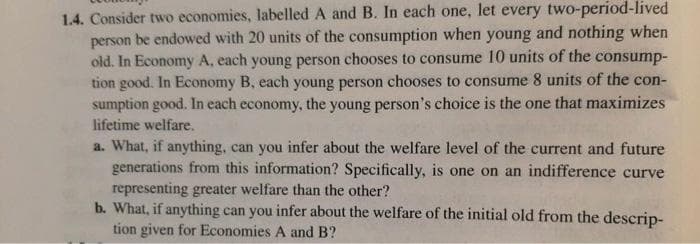1.4. Consider two economies, labelled A person be endowed with 20 units of the consumption when young and nothing when old. In Economy A, each young person chooses to consume 10 units of the consump- tion good. In Economy B, each young person chooses to consume 8 units of the con- sumption good. In each economy, the young person's choice is the one that maximizes lifetime welfare. a. What, if anything, can you infer about the welfare level of the current and future generations from this information? Specifically, is one on an indifference curve representing greater welfare than the other? b. What, if anything can you infer about the welfare of the initial old from the descrip- tion given for Fir J.DO
1.4. Consider two economies, labelled A person be endowed with 20 units of the consumption when young and nothing when old. In Economy A, each young person chooses to consume 10 units of the consump- tion good. In Economy B, each young person chooses to consume 8 units of the con- sumption good. In each economy, the young person's choice is the one that maximizes lifetime welfare. a. What, if anything, can you infer about the welfare level of the current and future generations from this information? Specifically, is one on an indifference curve representing greater welfare than the other? b. What, if anything can you infer about the welfare of the initial old from the descrip- tion given for Fir J.DO
Microeconomics: Private and Public Choice (MindTap Course List)
16th Edition
ISBN:9781305506893
Author:James D. Gwartney, Richard L. Stroup, Russell S. Sobel, David A. Macpherson
Publisher:James D. Gwartney, Richard L. Stroup, Russell S. Sobel, David A. Macpherson
Chapter1: The Economic Approach
Section: Chapter Questions
Problem 3CQ
Related questions
Question

Transcribed Image Text:1.4. Consider two economies, labelled A and B. In each one, let every two-period-lived
person be endowed with 20 units of the consumption when young and nothing when
old. In Economy A, each young person chooses to consume 10 units of the consump-
tion good. In Economy B, each young person chooses to consume 8 units of the con-
sumption good. In each economy, the young person's choice is the one that maximizes
lifetime welfare.
a. What, if anything, can you infer about the welfare level of the current and future
generations from this information? Specifically, is one on an indifference curve
representing greater welfare than the other?
b. What, if anything can you infer about the welfare of the initial old from the descrip-
tion given for Economies A and B?
Expert Solution
This question has been solved!
Explore an expertly crafted, step-by-step solution for a thorough understanding of key concepts.
This is a popular solution!
Trending now
This is a popular solution!
Step by step
Solved in 2 steps

Knowledge Booster
Learn more about
Need a deep-dive on the concept behind this application? Look no further. Learn more about this topic, economics and related others by exploring similar questions and additional content below.Recommended textbooks for you

Microeconomics: Private and Public Choice (MindTa…
Economics
ISBN:
9781305506893
Author:
James D. Gwartney, Richard L. Stroup, Russell S. Sobel, David A. Macpherson
Publisher:
Cengage Learning

Economics: Private and Public Choice (MindTap Cou…
Economics
ISBN:
9781305506725
Author:
James D. Gwartney, Richard L. Stroup, Russell S. Sobel, David A. Macpherson
Publisher:
Cengage Learning

Macroeconomics: Private and Public Choice (MindTa…
Economics
ISBN:
9781305506756
Author:
James D. Gwartney, Richard L. Stroup, Russell S. Sobel, David A. Macpherson
Publisher:
Cengage Learning

Microeconomics: Private and Public Choice (MindTa…
Economics
ISBN:
9781305506893
Author:
James D. Gwartney, Richard L. Stroup, Russell S. Sobel, David A. Macpherson
Publisher:
Cengage Learning

Economics: Private and Public Choice (MindTap Cou…
Economics
ISBN:
9781305506725
Author:
James D. Gwartney, Richard L. Stroup, Russell S. Sobel, David A. Macpherson
Publisher:
Cengage Learning

Macroeconomics: Private and Public Choice (MindTa…
Economics
ISBN:
9781305506756
Author:
James D. Gwartney, Richard L. Stroup, Russell S. Sobel, David A. Macpherson
Publisher:
Cengage Learning

Exploring Economics
Economics
ISBN:
9781544336329
Author:
Robert L. Sexton
Publisher:
SAGE Publications, Inc

Principles of Economics 2e
Economics
ISBN:
9781947172364
Author:
Steven A. Greenlaw; David Shapiro
Publisher:
OpenStax
